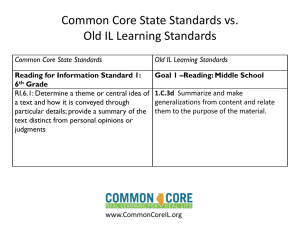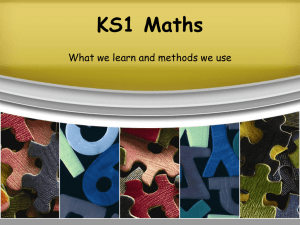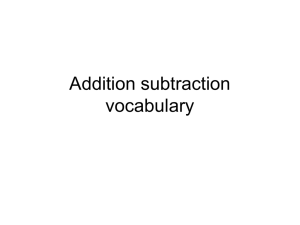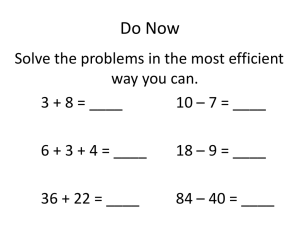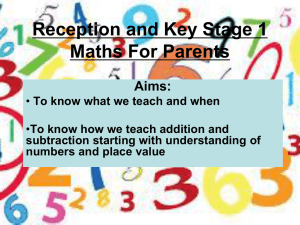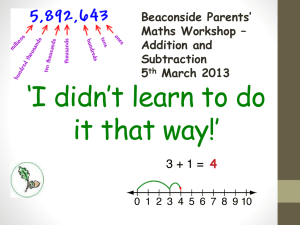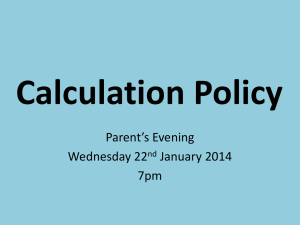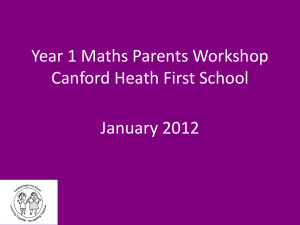MNS Grade 2 Parent Math Workshop
advertisement
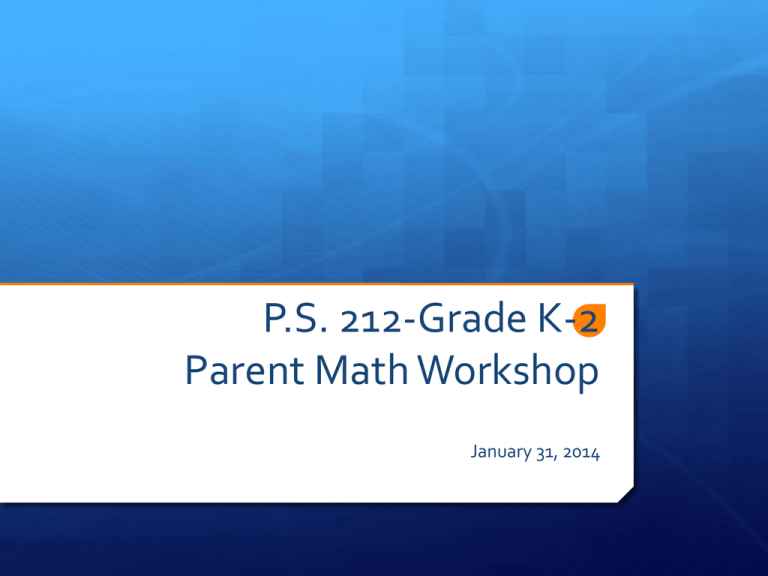
P.S. 212-Grade K-2 Parent Math Workshop January 31, 2014 What is it you want your children to learn in Math? We want your children to be problem solvers, to help them develop a number sense and fluency. What is a number sense? Number Sense refers to a person’s understanding of number concept, operations and applications of number and operations. It includes the ability and inclination to use this understanding in flexible ways to make mathematical judgments and to develop useful strategies for handling numbers and operations. A person with good number sense has the ability to use numbers and quantitative methods to communicate, process, and interpret information. Alistair McIntosh Number Sense It builds capacity for doing mental math It involves the flexible decomposition of numbers (a very big idea in mathematics!) What is a number sense? Please solve the following using multiple strategies: 387+ 464? Fluency Having efficient and accurate methods for computing Flexibility in computational methods Understand and explain methods Produce accurate answers efficiently Understands base 10 number system Understands number relationships eg. What is the sum of 8+9= Expectations for each grade according to the Common Core Standards Kindergarten Decompose numbers less than or equal to 10 into parts in more than one way, e.g., by using objects of drawings, and record each decomposition by a drawing or equation (e.g., 5=2+3 and 5=4+1) Strategies • Organizing & keeping track • Counting all & Counting on • One-to-One Tagging: touch each object once and only once • Synchrony: one word for every object • Subitizing: identify quantities up to 5 without counting Kindergarten Models • Fingers Ten Frame • Math Rack What this looks like in Kindergarten Example: Six crayons are in the box. Two are red and the rest are blue. How many blue crayons are in the box? Student: I got 6 crayons. I moved these two over and pretended they were red. Then, I counted the “blue” ones... 1, 2, 3, 4. Four. There are 4 blue crayons. Expectations for each grade according to the Common Core Standards 1st grade Use addition and subtraction within 20 to solve word problems involving situations of adding to, taking from, putting together, taking apart, and comparing, with unknowns in all positions, e.g., by using objects, drawings, and equations with a symbol for the unknown number Add within 100, including adding a two-digit number and a one-digit number, and adding a two-digit number and a multiple of 10, using concrete models or drawings and strategies based on place value, properties of operations, and/or the relationship between addition and subtraction; relate the strategy to a written method and explain the reasoning used. Understand that in adding two-digit numbers, one adds tens and tens, ones and ones; and sometimes it is necessary to compose a ten. First Grade Big Ideas Understanding the relationship between addition and subtraction The commutative property Composing and decomposing of numbers Strategies Using the 5- and 10-structures (using the 10’s frame and/or the math rack) Counting On Skip Counting Using Doubles and Near Doubles Using Compensation Making 10 What this looks like in first grade 42 cubes can be grouped many different ways and still remain a total of 42 cubes. 4 tens and 2 ones 42 ones 2 tens and 22 ones Expectations in each grade according to the Common Core Standards 2nd grade Add and subtract within 1000, using concrete models or drawings and strategies based on place value, properties of operations, and/or the relationship between addition and subtraction; relate the strategy to a written method. Understand that in adding or subtracting three-digit numbers, one adds or subtracts hundreds and hundreds, tens and tens, ones and ones; and sometimes it is necessary to compose or decompose tens or hundreds. Use addition and subtraction within 100 to solve one- and two-step word problems involving situations of adding to, taking from, putting together, taking apart, and comparing, with unknowns in all positions, e.g., by using drawings and equations with a symbol for the unknown number to represent the problem Students are expected to fluently add and subtract using the standard algorithm by the end of grade 4 2nd Grade Big Ideas Equivalency 5 cent + 25 cent = 10c +10c +10c Associative Property of Addition (9 + 3) + 7 = 9 + (3 + 7). Expanded Form 19 + 21 = (10 + 9) + (20 + 1) Subtraction as removal, difference, and used to find missing addends and subtrahends Place Determines Value Organize and represent mathematical thinking Strategies Counting On or Counting back Keeping one number whole Compensation, Regrouping Partial Sums Using Landmark or “friendly” numbers Using known addition and subtraction facts What this looks like in second grade Example: There were 17 students on the bus. Some more children got on. Then there were 32. How many came on? 17+?=32 Student A: I used a number line. I plotted the 17 and then I plotted the 32. The distance between the two is the amount of children who got on the bus. I jumped 10 which brought me to 27. I then jumped 3 more to bring me to a 10s number which is 30. I then jumped 2 more to bring me to 32. I added up the total jumps which was 15. 15 children got on the bus. Why use multiple strategies? Addition Strategies The following addition strategies reinforce and deepen place value understanding. They build capacity for doing mental math, and they involve the flexible decomposition of numbers. Split both numbers and add 57 + 28 50+20=70 7+8=15 (doubles +1) 70+14= 84 Keep one number whole and add the other in parts 64 + 28 = 92 64+20=84 84+8=92 Use an “I know” fact 8+7=? I know 7+7=14 so 7+8=15 compensation to solve an equivalent 49+51=(49+1) + (51-1)= 50+50 286 + 354 = (286 + 14) + (354 -14)= 300 + 340 = 640 A Number String in 1st Grade The number string routine How often do we do number strings? The expectations Student talk and ownership math An example… ( a string from last week) Choose a strategy to solve: 248+ 49 114+44 139+ 43 39+38 218+ 456 387+ 464? (Would you do this differently now?) Do students need to memorize math facts? YES!!! According to the common core standards by the end of second grade students are expected to add and subtract within 20, demonstrating fluency for addition and subtraction within 10. Use strategies such as counting on; making ten (e.g., 8 + 6 = 8 + 2 + 4 = 10 + 4 = 14); decomposing a number leading to a ten (e.g., 13 – 4 = 13 – 3 – 1 = 10 – 1 = 9); using the relationship between addition and subtraction (e.g., knowing that 8 + 4 = 12, one knows 12 – 8 = 4); Creating equivalent but easier or known sums (e.g., adding 6 + 7 by creating the known equivalent 6 + 6 + 1 = 12 + 1 = 13). We begin to memorize math facts in Kindergarten In Summary Each of the strategies taught allows students to make a choice. When students consider the elements in a problem and select a reasonably efficient strategy that makes sense given the numbers or the context, they are thinking like mathematicians. Mathematics is the study of relationships. Seeing math as the study of relationships enables us to see structural logic rather than just a series of random facts and procedures. What can parents do at home? Have conversations that relate to everyday life and incorporate math questions (eg. How tall is that tree?) Become familiar with the new math standards Practice counting objects and money Practice telling time everyday Reason through questions with your children. Play board games
